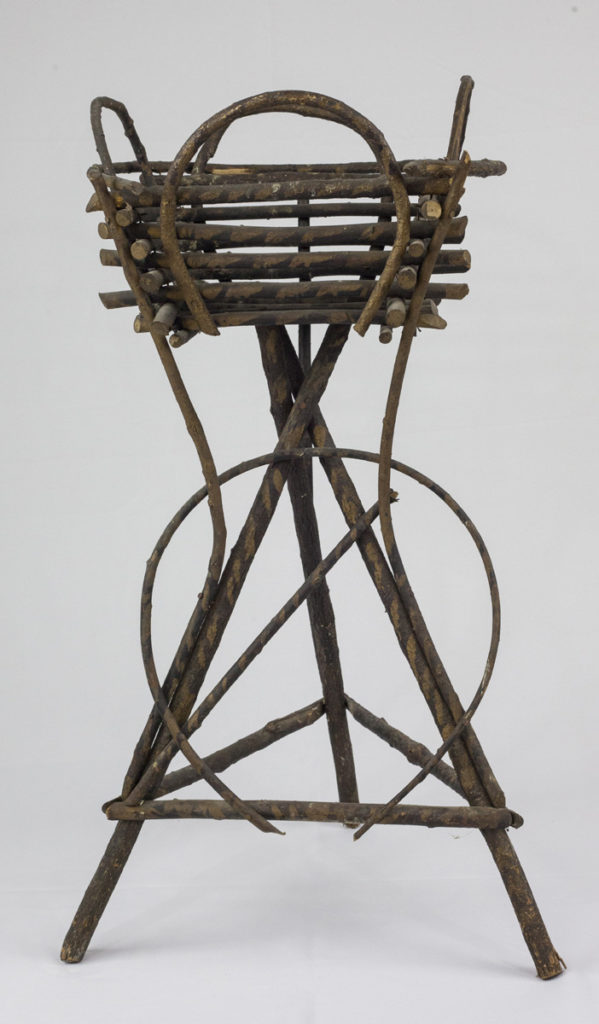Made in America with Foreign Parts
17 Plant Stand
 |
Plant Stand American Neighbor of Stugard Family, 1899 Wood (willow sapling) Gift of Lucille (Stugard) McKee MHAHS 2001.101.0121 |
This handmade willow plant stand was once a neighbor’s wedding gift to a young farming couple from Wisconsin’s Springdale township. Toward the end of the 19th century, the Arts and Crafts Movement shaped England and America’s preference for artistic handmade domestic goods. Movement commentators emphasized the economic and moral health of communities whose members practiced artistic skills utilizing local resources. Such sentiments survive in today’s non-professional Do-It-Yourself culture and professional crafts, which market the decorative appeal of rustic, unfinished furnishings and home adornments.
For a complete essay on this object, click here.
This 1899 Plant Stand exemplifies rural handicrafts in the Midwest circa 1900 while commenting on 19th century do-it-yourself, or D.I.Y. culture, not entirely different from our own in 2017. Today, a web search for willow or twig furniture returns dozens of do-it-yourself samples from popular craft sites such as Etsy, Pinterest, and HGTV announcing nostalgic descriptors such as “homemade” and “rustic”. Woven into the twists and folds of willow furniture is a craft tradition still alive today, sustained by practiced craftsman or by novice consumers drawn to the rustic charm of unrefined accessories.
Such 19th through 21st-century craftsman share common experiences involved in gathering and utilizing resources from the land in aesthetic and utilitarian ways that contribute to a sense of place-connectedness and to community prosperity. Some 19th century writers advocated for the transformative power of crafts for the well-being of the entire rural community. At the same time, the craftsman’s individual talent and character was essential to their practice. Commentator on the American Arts and Crafts Movement, Zueblin says, “thus are fashioned objects to be cherished and valued on account of their personal feeling and character, and such are the fireside arts done by talented individuals.”[1] Such sentimental writings on the Arts and Crafts movement expresses the romance such objects held for people in 1903.
Twig furniture, occasionally referenced in 19th and 20th century home fashion magazines, is typically associated with anonymous craftsmen and rustic styles, appealing to consumers’ desire for local and natural materials. In the case of the Stugard plant stand, the craftsman is unidentified; even their sex and trade are unknown, shrouding him or her in a degree of mystery. Though the plant stand’s anonymous maker leaves viewers with little indication of his or her personal biography, the plant stand, a neighbor’s wedding gift preserved for over 100 years, likely possessed the “cherished and valued” personal worth Zueblin describes. Furthermore, the Zueblin connects rural handicraft with ties to both nature and personal feeling along with the satisfaction of working out technical problems and skill development.
In addition to speaking to the 19th and early 20th century philosophies on the qualities of a prosperous rural town dependent upon the participation and skill specialization of its population, the plant stand is an interesting impression of a much larger 19th and early 20th-century interest in wicker or rattan furnishings often made from willow twigs, reeds, and other pliant twig plants. In her book, Rustic Furniture, Sue Honacker Stephenson argues that twig furniture possesses a “decorative symbolism” that functions as a rebellion against commercial and industrial excess, an ideology directly referencing and responding to the Arts and Crafts Movement. She goes on to interpret the furniture as a statement against modern consumption though the objects denial of industrial facture and its embrace of unfinished material. “As a decorative symbol, a rustic seat is astonishingly literal, being constructed of the bare roots of trees.”[2] Richard Saunders claims that wicker furniture “captured the mood of the times to a ‘T,’ reveling in the adoration of the home as an island of refuge that celebrated any handmade or eclectic decoration.”[3] Likewise, countless primary sources, from advertisements to articles on home decoration, emphasize the appeal of willow furnishings. Between 1911 and 1915, the periodical Art & Decoration published articles by various authors titled “The Informal Note in Summer Furniture,” “The Use and Beauty of Willow Furniture,” (Figure 4.) and “The Adaptable Willow: Its Appeal of Structure Line and Form.” (Figure 5.)[4] At the same time, advertisements use language such as “The Final Note of Comfort,” “Hand – Wrought Willow Furniture commands a place in even the most lavish home,” “no other investment insures artistic results at such a low cost,” (Figure 6.) [5] and “see these unique pieces to realize the home-like atmosphere they impart.”[6] Advertisements highlight desirable qualities inherent in willow furnishings including being handmade, artistic, and low cost.
Handmade willow plant stands demonstrate the resourcefulness and skill of the 19th century rural community and the anonymous individuals that contributed to binding and supportive relationships that created a prosperous community unit. Aesthetically appealing wicker furnishings introduced nature to the home through its rustic, natural finish and simple, plantlike structure, resonating with both ideals of natural beauty and tranquility as well as contemporary home fashions with its class implications. In developing and exercising their skill, rural craftsmen supported both the utilitarian as well as aesthetically moralizing needs of his or her community.
References
[1] Rho Fisk Zueblin, “The Arts and Crafts Movement: The Production of Industrial Art in America II,” The Chautauquan; A Weekly Newsmagazine (1880-1914) 37 (April 1903): 59.
[2]Sue Honacker Stephenson, Rustic Furniture. (New York: Van Nostrand Reinhold Company, 1979).
[3] Richard Saunders, The Collector’s Guide to American Wicker Furniture, (New York: Hearst Books, 1983).
[4] Matlock Price, “The Adaptable Willow: Its Appeal of Structural Line and Form,” Arts & Decoration (1910-1911) 1 (October 1911): 482-483.; D. D. McCall, “The Use and Beauty of Willow Furniture.” Arts & Decoration (1910-1911) 1 (March 1911): 221-222.; Mortimer Marke, “The Informal Note in Summer Furniture,” Arts & Decoration (1910-1918) 10 (April 1915): 232-233.
[5] “Back Matter.” Arts & Decoration. (September 1911): 456.
[6] Advertisement by Joseph P. McHugh & Son of New York.

